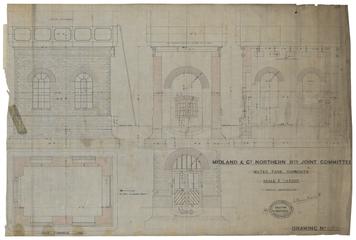
Melton Constable Locomotive Works
The site of the works was original chosen by the Lynn and Fakenham Railway who undertook the initial building. The new works at Melton Constable were initially built and brought into operation by Mr J W Mann who had been appointed Locomotive Superintendent of the Lynn and Fakenham Railway in 1880. On 10th May 1881 the first track was laid, the foundations of the various shops were put in, part of the walls put up and the framework of many houses in Melton Street erected. Although commenced by the L&FR, completion was carried out by the Eastern & Midlands Railway.
The Works were brought into operation in 1883 by the Eastern & Midlands Railway when the local locomotive shops at Yarmouth and Fakenham were closed and all heavy repairs were transferred to Melton Constable. Mr JW Mann, who had overseen the construction of the works, resigned in 1884 and William Marriott, who had become Civil Engineer of the Eastern & Midlands in 1883, was appointed Locomotive Superintendent.
The works were compact and well equipped. The erecting shop had two roads and there was a machine shop, boiler shop, forge, smithy and other ancillary shops. Before the erecting shop was completed, lighter work, such as wheel removal, had been carried out in the open. The layout consisted of one island providing two 800 ft platforms enabling long trains to be divided as required. Most of the platforms were roofed.
Melton Constable Works not only repaired existing stock supplied to the former companies but also built a number of new vehicles. In 1902, for example, the works turned out some trucks for travelling oil-gas holders, the trucks being made and erected in the carriage and wagon shop the twin 4 ft. 0 ins. diameter x 17 ft. 2 ins. long dish ended tanks being dealt with by the boiler shop and hydraulically tested to 10 psi. During the whole of this period maintenance work at Melton covered not only railway vehicles but the large fleet of horse-drawn delivery vans and trolleys as well.
William Newman (Mr. Marriott’s first mechanical draughtsman and Chief Assistant to the Locomotive Superintendent since 1893) succeeded William Marriott as Resident Mechanical Engineer. He, like his predecessor, was faced with the ever-present demand for greater motive power to deal with the heavier trains, especially the summer excursions. No new engines were forthcoming and he tackled the problem by maintaining a rigidly high standard of maintenance of both locomotives and passenger stock. Mr. Newman retired in 1932.
He in turn was succeeded by Mr. A.H. Nash from Derby works. Apart from blast nozzle and chimney modifications, no fundamental changes were made to the engines in general during his period in charge and no new type of locomotive or new design was undertaken at Melton up to its closure. Mr. Nash left Melton in 1937 after the L&NER took charge.
From 1921 and onwards the Melton shops were on short time and were closed on Saturdays from 25th October 1930. On 1st October 1936 the Joint locomotive stock was transferred to the L&NER. Steadily between 1936 and 1945 the old engines were gradually withdrawn and broken up. However two of the sturdy shunting tanks lasted long enough to be taken in to British Railways stock in 1948.
The Works closed in October 1936 and the Melton Gasworks finally closed on 3rd March 1962.